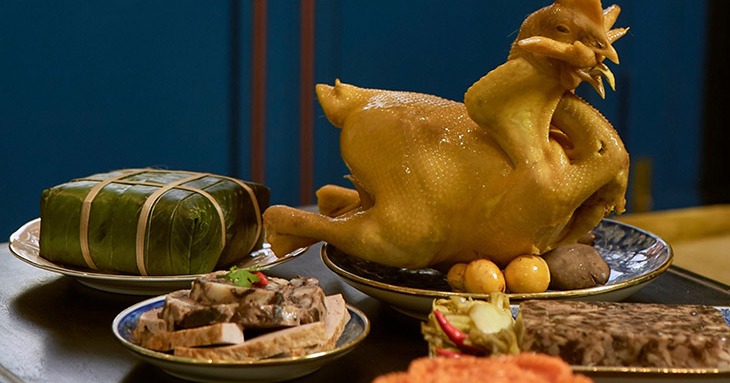Tet Nguyen Dan, or Lunar New Year, is not only a time for family reunions and celebrating the arrival of spring but also an opportunity to honor ancestors through elaborate and meaningful feasts. The dishes prepared for Tet are rich in cultural symbolism, each one carrying wishes for a prosperous and happy new year. Here’s a look at the essential dishes that appear on the Tet table, as well as the meanings behind them.
The Important New Year’s Eve Feast
The New Year’s Eve meal, known as bữa cỗ giao thừa, is one of the most important meals during Tet. It marks the farewell to the old year and the welcoming of the new year. This feast is filled with special dishes, including:
Chicken with Rose in Its Beak: A traditional dish where a chicken is prepared with a rose in its beak. The chicken represents fertility, growth, and new beginnings, while the rose symbolizes prosperity and good fortune in the coming year.
The Five-Fruit Tray (Mâm Ngũ Quả): The five-fruit tray is an essential part of Tet celebrations. It usually contains five different types of fruit, each symbolizing one of the five elements: metal, wood, water, fire, and earth. Common fruits include bananas, oranges, pomelos, custard apples, and mangoes. This tray is not only a symbol of prosperity but also a way to ask for the blessings of ancestors for a peaceful and prosperous year.
Sticky Rice (Xôi): Sticky rice is a staple food during Tet, often served in variations such as xôi gấc (gac sticky rice) or xôi đậu xanh (green bean sticky rice). It represents abundance and wealth, making it a perfect addition to the Tet feast.
The Feast for the Kitchen Gods (Mâm Cúng Ông Công, Ông Táo)
Before Tet, families honor the Kitchen Gods (Táo Quân) with a special feast on the 23rd day of the lunar calendar. This meal is meant to send the Kitchen Gods back to Heaven with good offerings for the family. The dishes typically include:
Boiled Chicken: A symbol of completeness and respect, the boiled chicken is a common offering to the Kitchen Gods. It’s seen as a pure, wholesome dish to honor the spirits.

Bánh Chưng: Bánh Chưng, a square-shaped sticky rice cake filled with mung beans and pork, is a traditional dish symbolizing the Earth. It’s essential for honoring ancestors and the land.
The Five-Fruit Tray: The same fruit tray used for New Year’s Eve, symbolizing good fortune and prosperity for the family, is also present in the offering to the Kitchen Gods.
Wine and Tea: These beverages are often included in the offering to show respect and to wish for protection and prosperity in the coming year.
The Meaning of the Five-Fruit Tray (Mâm Ngũ Quả)

The Five-Fruit Tray is one of the most iconic symbols of Tet. Each fruit represents a different wish for the coming year:
Bananas: Represent unity and togetherness, as their clusters symbolize harmony and family bonds.
Oranges: Symbolize happiness and wealth, often linked to good fortune and success.
Pomelos: Associated with prosperity, pomelos are believed to bring wealth and good luck.
Custard Apples: These represent good health and the hope for a sweet life ahead.
Mangoes: Symbolizing success and growth, mangoes are wished for a fruitful and prosperous future.
The five-fruit tray, with its variety of colors and shapes, is not just a decorative centerpiece but also a way of sending prayers and blessings to the ancestors.
Essential Dishes for Tet

In addition to the New Year’s Eve feast and offerings to the Kitchen Gods, several other dishes are considered essential during Tet:
Bánh Chưng, Bánh Tét: These traditional rice cakes, one square (Bánh Chưng) and the other cylindrical (Bánh Tét), are filled with sticky rice, mung beans, and pork. They are essential on the Tet table, symbolizing the Earth and expressing gratitude to the land and ancestors.
Pickled Onions and Shallots (Dưa Hành, Củ Kiệu): These are often served alongside the rice cakes to balance the richness of the food and refresh the palate.
Braised Pork with Eggs (Thịt Kho Hột Vịt): A popular dish in southern Vietnam, this dish symbolizes abundance and family unity, as it’s often served in large portions for sharing among loved ones.
Tet Sweets (Mứt Tết): Various types of candied fruits and vegetables, such as coconut, ginger, or lotus seeds, are common snacks during Tet. These sweets are enjoyed throughout the holiday and bring a sense of joy and sweetness to the festivities.
Conclusion
The Tet feast is more than just a meal; it is a reflection of the cultural values and traditions of Vietnam. Each dish and each ingredient is chosen with care, symbolizing hopes for prosperity, health, and happiness in the coming year. Whether it’s the iconic five-fruit tray, the sacred bánh chưng, or the family favorites like braised pork, the Tet meal is an essential part of welcoming the new year with joy and gratitude. Sharing these dishes with loved ones is a reminder of the importance of family, tradition, and new beginnings during Tet.







